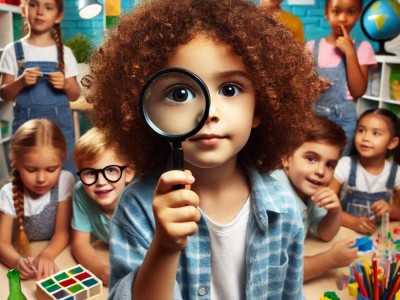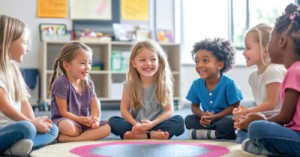Inquiry-based learning in early childhood is a powerful approach that nurtures children's natural curiosity and encourages them to explore, ask questions, and discover answers through hands-on experiences. The following article provides information on the Benefits Of Implementing Inquiry Based Learning, Steps to Implement Inquiry-Based Learning, Guide Children In Inquiry Based Learning and more.
Benefits Of Implementing Inquiry-Based Learning
-
Child-Centered Approach: Inquiry-based learning places the child at the center of the learning process. Children are encouraged to ask questions, explore their interests, and take an active role in their learning journey.
-
Encourages Curiosity: This approach fosters a sense of wonder and curiosity in children. By allowing them to investigate topics that interest them, children become more engaged and motivated to learn.
-
Develops Critical Thinking: Inquiry-based learning helps children develop critical thinking and problem-solving skills. They learn to observe, ask questions, make predictions, and test their ideas through experimentation.
-
Promotes Collaboration: Children often work together in inquiry-based activities, which promotes collaboration and social skills. They learn to share ideas, listen to others, and work as a team to solve problems.
-
Supports Holistic Development: This approach supports the holistic development of children by integrating various areas of learning, such as language, math, science, and social skills. It provides opportunities for children to develop a wide range of skills and knowledge.
Steps to Implement Inquiry-Based Learning
-
Start with a Question: Begin with an open-ended question or problem that sparks children's curiosity. For example, "What happens to plants when they don't get enough water?"
-
Plan and Explore: Guide children in planning their investigation. Provide materials and resources that support their exploration. Encourage them to make observations, ask questions, and gather information.
-
Experiment and Investigate: Allow children to conduct experiments and explore their ideas. This hands-on approach helps them understand concepts and develop practical skills.
-
Reflect and Discuss: Create opportunities for children to reflect on their findings and discuss their experiences. Encourage them to share their observations, ask further questions, and think about what they have learned.
-
Document Learning: Document the children's learning process through photos, videos, drawings, and written records. This helps track their progress and provides a valuable resource for reflection and assessment.
How To Guide Children In Investigating In Inquiry-Based Learning
Guiding children in investigating during inquiry-based learning involves fostering their natural curiosity and providing the support they need to explore and discover. Here are some strategies to help you guide children effectively:
-
Encourage Questions: Start by encouraging children to ask questions about the world around them. Use open-ended questions to spark their curiosity and guide their investigations. For example, "What do you think will happen if we mix these two colors?"
-
Provide Resources: Offer a variety of materials and resources that children can use to explore their questions. This can include books, art supplies, science tools, and digital devices. Ensure that the resources are accessible and age-appropriate.
-
Create a Safe Environment: Establish a safe and supportive environment where children feel comfortable taking risks and making mistakes. Encourage them to try new things and reassure them that it's okay if their experiments don't always work out as planned.
-
Model Inquiry: Demonstrate the inquiry process by asking questions, making predictions, and conducting experiments alongside the children. Show them how to observe, record, and analyze their findings.
-
Facilitate Exploration: Guide children in planning and conducting their investigations. Help them develop a plan, gather materials, and carry out their experiments. Provide support and guidance as needed, but allow them to take the lead.
-
Encourage Collaboration: Promote collaboration by encouraging children to work together on their investigations. This helps them learn from each other, share ideas, and develop social skills.
-
Reflect and Discuss: Create opportunities for children to reflect on their investigations and discuss their findings. Ask questions that prompt them to think critically about their results and consider what they have learned.
-
Document Learning: Encourage children to document their investigations through drawings, photos, videos, and written records. This helps them track their progress and provides a valuable resource for reflection and assessment.
-
Celebrate Discoveries: Celebrate children's discoveries and achievements, no matter how small. This reinforces their efforts and motivates them to continue exploring and learning.
By using these strategies, you can create a dynamic and engaging learning environment that supports children's natural curiosity and fosters a love of learning through inquiry-based investigations.
How To Encourage Children To Reflect and Discuss
Encouraging children to reflect and discuss their learning experiences is a valuable part of the inquiry-based learning process. Here are some strategies to help foster reflection and discussion:
-
Create a Reflective Environment: Set up a quiet and comfortable space where children can think and talk about their experiences. This could be a cozy corner with cushions and books or a designated reflection area.
-
Use Open-Ended Questions: Ask open-ended questions that encourage children to think deeply and express their thoughts. For example, "What did you enjoy most about this activity?" or "How did you solve that problem?"
-
Model Reflective Thinking: Demonstrate reflective thinking by sharing your own thoughts and experiences. For example, "I noticed that when we worked together, we were able to build a taller tower. What do you think helped us succeed?"
-
Encourage Peer Discussions: Facilitate group discussions where children can share their ideas and listen to others. Encourage them to ask questions and build on each other's thoughts.
-
Use Visual Aids: Provide visual aids such as charts, drawings, or photos to help children remember and reflect on their experiences. For example, you can create a "reflection wall" where children can post their thoughts and drawings.
-
Incorporate Reflection into Daily Routine: Make reflection a regular part of the daily routine. Set aside time for children to think about their day and share their experiences with the group.
-
Celebrate Achievements: Acknowledge and celebrate children's achievements and efforts. This helps them feel valued and encourages them to reflect on their successes.
-
Document Learning: Encourage children to document their learning through drawings, writing, or digital media. This helps them organize their thoughts and provides a tangible record of their reflections.
-
Provide Feedback: Give constructive feedback that encourages children to think about their learning process. For example, "I noticed you tried a new strategy today. How did that work for you?"
-
Encourage Self-Assessment: Help children develop self-assessment skills by asking them to evaluate their own work and set goals for improvement. For example, "What do you think you did well, and what would you like to do differently next time?"
By using these strategies, you can create a supportive environment that encourages children to reflect on their learning experiences and engage in meaningful discussions.
Examples Of Reflective Thinking
Reflective thinking is a valuable skill that helps children and adults alike to analyze their experiences, learn from them, and apply that knowledge to future situations. Here are some examples of reflective thinking activities for children
-
Reflection Journals: Encourage children to keep a journal where they can write or draw about their daily experiences. Ask them to reflect on what they learned, what they enjoyed, and what they found challenging.
-
Group Discussions: After completing a group activity, gather the children together to discuss what they did, what worked well, and what they could do differently next time. This helps them learn from each other and think critically about their actions.
-
Think-Pair-Share: Use the think-pair-share strategy where children first think about a question or problem individually, then discuss their thoughts with a partner, and finally share their ideas with the larger group. This encourages them to reflect on their own thinking and consider different perspectives.
-
Role-Playing: Have children role-play different scenarios and then reflect on their actions and decisions. For example, they can act out a conflict resolution situation and discuss what strategies worked best.
-
Art Reflection: After completing an art project, ask children to reflect on their creative process. Questions like "What inspired your artwork?" and "What did you enjoy most about creating this piece?" can help them think about their artistic choices.
-
Self-Assessment: Provide children with self-assessment checklists or rubrics to evaluate their own work. Encourage them to think about what they did well and what they can improve on.
-
Storytelling: Have children tell stories about their experiences and reflect on the lessons they learned. This can be done through oral storytelling, writing, or drawing.
-
Reflection Circles: Create a circle time where children can share their thoughts and reflections on a particular topic or activity. This fosters a sense of community and encourages open communication.
-
Mind Maps: Use mind maps to help children organize their thoughts and reflect on their learning. They can create visual representations of their ideas and see how different concepts are connected.
-
Question Prompts: Provide children with question prompts to guide their reflection. Questions like "What was the most interesting thing you learned today?" and "How did you solve a problem you faced?" can help them think more deeply about their experiences.
By incorporating these reflective thinking activities, you can help children develop critical thinking skills, self-awareness, and a deeper understanding of their learning experiences.
Example Questions To Ask Children For Inquiry Based Learning
Here are some example questions to ask for inquiry-based learning in early childhood education:
-
Science and Nature:
-
What do you think will happen if we plant this seed in the soil?
-
How do you think animals stay warm in the winter?
-
What can we find if we dig in the garden?
-
-
Math and Numbers:
-
How many blocks do you think we need to build a tower as tall as you?
-
What shapes can you find in our classroom?
-
How can we measure how much water is in this container?
-
-
Art and Creativity:
-
What colors do you think we can make by mixing these paints?
-
How can we use these materials to create a sculpture?
-
What story can you tell with your drawing?
-
-
Community:
-
What do you think people do at the fire station?
-
How do you think we can help keep our community clean?
-
What do you think it would be like to live in a different country?
-
-
Language and Literacy:
-
What do you think will happen next in this story?
-
How can we make our own book?
-
What words can you think of that start with the letter "B"?
-
-
Physical Activity and Movement:
-
How can we move our bodies to look like different animals?
-
What games can we play with this ball?
-
How can we create an obstacle course in our playground?
-
These questions are designed to spark curiosity and encourage children to explore, investigate, and think critically about the world around them. By asking open-ended questions, you can create a rich and engaging learning environment that supports inquiry-based learning.
Example Activities
-
Nature Exploration: Take children on a nature walk to observe plants, animals, and insects. Encourage them to ask questions and collect samples for further investigation.
-
Science Experiments: Conduct simple science experiments, such as mixing baking soda and vinegar to observe a chemical reaction. Let children make predictions and record their observations.
-
Building Projects: Provide materials for children to build structures, such as bridges or towers. Encourage them to test their designs and make improvements based on their findings.
-
Art and Creativity: Use art projects to explore concepts like color mixing or texture. Allow children to experiment with different materials and techniques.
Further Reading
Inquiry Based Learning For Toddlers
Project-Based Learning In Early Childhood
Inquiry Based Learning Questions Posters
Pedagogical Approaches In Early Childhood







 As an Educator in Australia, your pay rate falls under the Children’s Services Award 2010. This award states the minimum amount that an employer can
As an Educator in Australia, your pay rate falls under the Children’s Services Award 2010. This award states the minimum amount that an employer can When working as a qualified Early Childhood Teacher (with a university degree) within a service, your rate of pay will come from the Educational Services
When working as a qualified Early Childhood Teacher (with a university degree) within a service, your rate of pay will come from the Educational Services When working as a Diploma Qualified Educator your pay rate is from the Children's Services Award 2010. This Award states your minimum rate of pay
When working as a Diploma Qualified Educator your pay rate is from the Children's Services Award 2010. This Award states your minimum rate of pay When working as a Cert 3 Qualified Educator, your pay rate is from the Children's Services Award 2010. This Award states your minimum rate of
When working as a Cert 3 Qualified Educator, your pay rate is from the Children's Services Award 2010. This Award states your minimum rate of Educational Leaders play a crucial role in their early childhood service by ensuring that the educational program aligns with best practices and supports the holistic
Educational Leaders play a crucial role in their early childhood service by ensuring that the educational program aligns with best practices and supports the holistic In early childhood education and care, ratios are more than a technicality—they are a frontline safeguard. Every child deserves responsive supervision, emotional connection, and developmental
In early childhood education and care, ratios are more than a technicality—they are a frontline safeguard. Every child deserves responsive supervision, emotional connection, and developmental Here’s a comprehensive Mobile Phone and Smart Watch Policy tailored for early childhood education and care (ECEC) services in Australia, aligned with the latest 2025
Here’s a comprehensive Mobile Phone and Smart Watch Policy tailored for early childhood education and care (ECEC) services in Australia, aligned with the latest 2025 With the new national child safety reforms kicking in on 1 September 2025, early childhood services like yours have a real opportunity to lead the
With the new national child safety reforms kicking in on 1 September 2025, early childhood services like yours have a real opportunity to lead the The Sea of Fish Challenge is a national initiative that invites children, educators, families, and communities to create and display fish artworks as a symbol
The Sea of Fish Challenge is a national initiative that invites children, educators, families, and communities to create and display fish artworks as a symbol Across the early childhood education and care sector, educators are sounding the alarm: current staffing ratios are insufficient to deliver safe, meaningful, and developmentally appropriate
Across the early childhood education and care sector, educators are sounding the alarm: current staffing ratios are insufficient to deliver safe, meaningful, and developmentally appropriate


